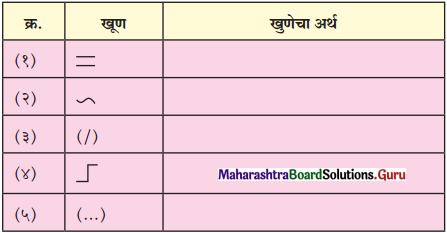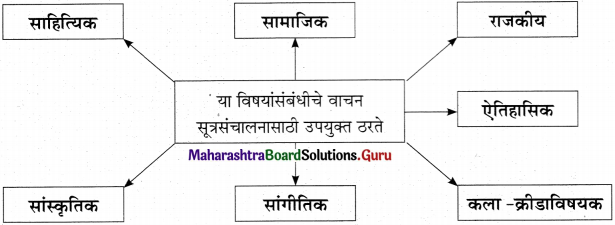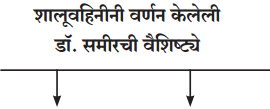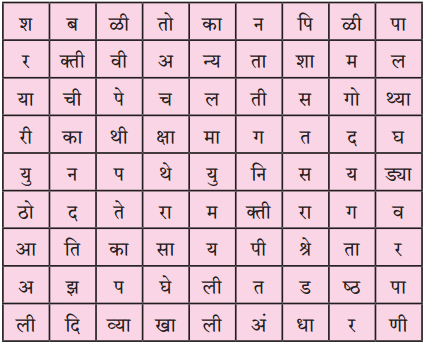Balbharti Maharashtra State Board Marathi Yuvakbharati 11th Digest Bhag 4.4 अनुदिनी (ब्लॉग) लेखन Notes, Textbook Exercise Important Questions and Answers.
11th Marathi Bhag 4.4 Exercise Question Answer Maharashtra Board
अनुदिनी (ब्लॉग) लेखन 11 वी मराठी स्वाध्याय प्रश्नांची उत्तरे
11th Marathi Digest Chapter 4.4 अनुदिनी (ब्लॉग) लेखन Textbook Questions and Answers
कृती
खालील कृती करा.
प्रश्न 1.
अनुदिनी लेखनाची गरज स्पष्ट करा.
उत्तरः
अनुदिनी किंवा ब्लॉग हे एक सामाजिक माध्यम आहे. विविध विषयांवरील आपले व्यक्तिगत विचार समाजाला कळावे या उद्देशाने व्यक्तीने निर्माण केलेले ‘संकेतस्थळ’ म्हणजे ‘ब्लॉग’. आपले मत, विचार, कल्पना अभिव्यक्त करण्यासाठी संवादाचे प्रभावी माध्यम म्हणून अनुदिनी लेखन करता येते. अनुदिनी लेखन हे सामाजिक संपर्कस्थळ असल्याने त्यावर प्रसिद्ध होणारी माहिती अनेक वाचकांना उपयुक्त ठरू शकते. ‘अनुदिनी’चा उदय होण्यापूर्वी ‘डायरी लेखन’ केले जात होते. व्यक्ती त्याच्या आयुष्यातील दैनंदिन घडामोडींची नोंद त्या डायरीत करून ठेवत असे. ही डायरी त्याची त्याच्यापुरती खाजगी होती.
![]()
एक प्रकारे ती ‘स्व-अभिव्यक्ती’ होती. अशा लिहिलेल्या काही डायऱ्या नंतरच्या काळात सामाजिक-ऐतिहासिकदृष्ट्या अत्यंत महत्त्वाच्या ठरल्या. उदा. अॅन फ्रँक हिची डायरी, लक्ष्मीबाई टिळक यांनी लिहिलेली ‘स्मृतिचित्रे’ ही डायरी. त्यामुळे आज डायरी लेखनाचे महत्त्व अनन्यसाधारण आहे. पूर्वी हे लिखाण अनेकांपर्यंत जात नव्हते. परंतु आज ते अनेकांपर्यंत जावे, माहितीची विचारांची देवाण-घेवाण व्हावी, संवादाचे पूल बांधले जावेत, क्रिया-प्रतिक्रियांमधून विचारांचे कंगोरे समोर यावेत अशा अनेक कारणांमळे ‘अनदिनी’ची गरज निर्माण झाली आहे.
स्वविचार-स्वभावना यांना शिस्त आणि स्वातंत्र्याची जोड देऊन अभिव्यक्त होण्यासाठी ‘अनुदिनी’ हे उत्तम माध्यम आहे. त्यामुळे एखादया कार्यक्रमाची माहिती, एखादे छायाचित्र, चित्रफिती, पाककृती, प्रवासवर्णन, राजकीय मत मतांतरे अशा अनेक गोष्टी सगळ्यांपर्यंत पोहचवता येतात. याचा लाभ ती अनुदिनी वाचणाऱ्यांना होतो. ज्ञानाच्या कक्षा रुंदावतात. विचारांची देवाण-घेवाण होते. म्हणूनच अनुदिनी वाचणाऱ्यांची संख्या दिवसेंदिवस वाढत आहे.
प्रश्न 2.
अनुदिनी लेखनाची क्षेत्रे स्पष्ट करा.
उत्तरः
अनुदिनी लेखनाचे महत्त्व दिवसेंदिवस वाढत आहे. अनेक लोक अनुदिनी लेखन आणि वाचन यांचा उपयोग स्वजाणिवा विकसित करण्यासाठी करतात. वैयक्तिक अनभवाच्या अभिव्यक्तीसाठी निर्माण झालेल्या ‘अनदिनी’ने आपले कार्यक्षेत्र हळहळ विस्तारले आहे. व्यक्तिगत भावनांपास थेट निवडणुकीत मत मागण्यापर्यंत किंवा व्यक्ती-व्यक्तीतील हितगुज सार्वत्रिक करण्यापासून ते वस्तूची जाहिरात व विक्री करण्यापर्यंत ब्लॉगला कोणतेही क्षेत्र वर्ण्य नाही. ब्लॉगची क्षेत्रे ही खालील प्रमाणे आहेत.
- वैयक्तिक : यात व्यक्ती आपल्या दैनंदिन जीवनातील गोष्टी, आपले आवडते संगीत, नृत्य, एखादी सहल अशा अनेक बाबींवर व्यक्तिगत पातळीवरील विचार व्यक्त करते.
- सामाजिक : यात व्यक्ती सभोवताली घडणाऱ्या सामाजिक घटनांबाबत संवेदनशील असते. त्यावर आपले बरे-वाईट, सकारात्मक नकारात्मक विचार तिला व्यक्त करावेसे वाटतात. त्यातून मग साद-प्रतिसादाची वैचारिक साखळी तयार होते. विषयाचे विविध कंगोरे समोर येतात.
- व्यावसायिक : व्यवसायवृद्धी हे देखील ‘ब्लॉग’ निर्माण करण्याचे महत्त्वाचे कारण आहे. यात एखादे उत्पादन, त्याची वैशिष्ट्ये, एखादी सेवा, त्याविषयीच्या आर्थिक बाबी इत्यादींची माहिती दिली जाते.
- वाङ्मयीन : यामध्ये साहित्य आणि साहित्यातील विविध प्रवाह यांच्यावर लेखन होते. समीक्षात्मक लेखन ते थेट एखादे ललित . वाङ्मय असा हा प्रवास असू शकतो. काही वाङ्मयीन ब्लॉग एखादया लेखकाला वाहिलेला असतो. त्या लेखकाच्या साहित्याची चर्चा, ओळख तिथे नियमित करून दिली जाते. उदा. पु.ल. देशपांडे यांच्या नावाचा उपलब्ध असलेला ब्लॉग.
- सामूहिक : यात दोन-तीन व्यक्ती एकत्रितपणे लेखन करतात.
- पर्यटन : पर्यटन विषयाला वाहिलेले लेखन-यावर माहिती, पर्यटनस्थळे, चित्र, तिथले अनुभव यांची माहिती दिली जाते.
- शैक्षणिक : अनेक शैक्षणिक संस्थांचे स्वत:चे ब्लॉग आहेत. त्यावर शिक्षण विषयक घडामोडींची माहिती दिली जाते.
- राजकीय : यात राजकीय व्यक्ती स्वत:चे ब्लॉग निर्माण करून स्वत:च्या राजकीय-सामाजिक कार्याची माहिती लोकांपर्यंत पोहोचवतात.
उदा. I support Narendra Modi नावाचा ब्लॉग सतत पंतप्रधान नरेंद्र मोदी यांच्या विषयीची माहिती देत असतो.
![]()
प्रश्न 3.
चांगल्या अनुदिनीची वैशिष्ट्ये तुमच्या शब्दांत लिहा.
उत्तरः
ब्लॉग / अनुदिनी लिहिणाऱ्यांची संख्या मुबलक आहे. त्याद्वारे मनात येणारे विचार मुक्तपणे मांडले जातात. या लेखनाचे क्षेत्र जरी व्यापक असले तरी प्रत्येकाच्या आवडीचे क्षेत्र, प्राविण्याचे क्षेत्र भिन्न असते. ब्लॉग सुरू करताना जे विषय आवडतात, ज्या विषयांवर प्रभुत्व आहे अशा विषयांना प्राधान्य देणे योग्य ठरेल. हे लेखन करताना खालील गोष्टी लक्षात घेणे गरजेचे आहे.
- आकर्षक शीर्षक
- आकर्षक विषय मांडणी
- छोटी, सुटसुटीत, सोपी आणि आकलनसुलभ वाक्यरचना
- परिच्छेदांची समर्पक मांडणी.
- एका परिच्छेदातून दुसऱ्या परिच्छेदात जाण्याची सहजशैली
- रिकाम्या जागेचा योग्य वापर.
- वाचकांची उत्सुकता टिकवून ठेवणारी शैली
- संवादात्मकता
- दृक-श्राव्य किंवा श्राव्य फीतींची लिंक
- शब्द मर्यादेचे पालन, विषयातील अद्ययावतता / आधुनिकता
प्रश्न 4.
तुम्हांला उपलब्ध असलेली अनुदिनी वाचून त्यासंबंधीच्या तुमच्या प्रतिक्रिया स्पष्ट करा.
उत्तरः
सध्याच्या इंटरनेटच्या युगात ब्लॉगचे महत्त्व फारच वाढले आहे. असंख्य लोक आता मराठीतून ब्लॉग लिहू लागले आहेत. त्यातील काही ब्लॉग खरंच दर्जेदार असतात तर काही सुमार दर्जाचे. प्रत्येक वेळेला ब्लॉगचा URL टाकून त्या ब्लॉगवर जाणे, नवीन काही पोस्ट झाले आहे का हे पाहणे फारच त्रासदायक ठरू शकते. त्यामुळे ब्लॉग लिस्ट नावाच्या संकेतस्थळाला भेट हे खूपच सोयीचे आहे. वेगवेगळे ब्लॉग यावर जोडलेले आहेत.
प्रत्येकाची ताजी पोस्ट त्या ब्लॉगच्या नावावरच झळकत राहते त्यामुळे काय वाचावे हे लगेच ठरवता येते. ‘अक्षरगंध मनातले काही तरंग’, ‘लेखन प्रपंच’, ‘आनंदयात्रीचा ब्लॉग’, ‘झाले मोकळे आकाश’, ‘सहयाद्री बाणा’, ‘माझी वाङ्मय शेती’, ‘माझे ट्रेक अनुभव’ अशा अनेक ब्लॉगला एकाच ठिकाणी भेट देऊन सगळ्या ब्लॉगच्या ताज्या पोस्ट एकाच ठिकाणी वाचता येतात. यात गंगाधर मुटे हे ‘माझी वाङ्मय शेती’ या ब्लॉगमध्ये अभंगरचनेच्या आधारे शेतकरी जीवनावर काव्य रचना करतात ते वाचनीय असते. पु.ल. प्रेम नावाचा ब्लॉग मला खूप आवडतो.
याचा पत्ता आहे pulaprem.blogspot.com या ब्लॉगवर पु.ल. देशपांडे यांच्या ‘व्यक्ती आणि वल्ली’ या पुस्तकांतील व्यक्तिरेखा आहेत. शिवाय पु.लं.ची इतर पुस्तके, त्यांची भाषणे, पत्रे हे सगळे वाचायला मिळते. याशिवाय पु.लं.च्या पत्नी सुनीताताई देशपांडे यांचे लेखन वाचण्यास उपलब्ध आहे. शिवाय इतरांनी पुलंवर लिहिलेले लेखन उपलब्ध आहे. पु.लं.च्या काही कविता, विनोदी किस्से वाचायला मिळतात. समग्र पु.लं. अनुभवण्यासाठी हा एक उत्तम ब्लॉग आहे.
![]()
प्रश्न 5.
तुमची स्वत:ची अनुदिनी तयार करताना ती परिपूर्ण व आकर्षक होण्यासाठी पाळावयाची पथ्ये लिहा.
उत्तरः
ब्लॉग तयार करणे सोपं आहे. पण दर्जेदार ब्लॉग लेखन करणं ही कठीण बाब आहे. स्वत:ची अनुदिनी तयार करताना या अनुदिनीद्वारे आपण लोकांसमोर काय मांडणार आहोत याचा पक्का विचार प्रथम करणे गरजेचे आहे. अनुदिनीसाठी एखादे आकर्षक शीर्षक तयार करावे लागेल. जो विषय आपण अनुदिनीसाठी निवडला आहे त्या विषयाचे आपल्याला सखोल व्यवस्थित ज्ञान आहे का याची चाचपणी केली पाहिजे. एखादया विषयावर लेखन करताना भाषा आकर्षक-सुटसुटीत हवी. तशीच ती समजण्यास सोपी हवी. योग्य ठिकाणी परिच्छेदांची निर्मिती करणे गरजेचे आहे.
एका परिच्छेदाचा दुसऱ्या परिच्छेदाशी सहज संबंध जुळला जाईल असे लेखन हवे. जिथे रिकामी जागा आहे त्याचा समर्पक वापर करणे आवश्यक आहे. वाचकांना पुढेपुढे वाचत जावेसे वाटेल अशी लेखन शैली हवी. यात जर संवादात्मकता असेल तर अधिक उत्तम. आपण एका समूहाशी बोलतो आहोत असा भाषेचा बाज हवा. विविध चित्रे, दृक-श्राव्य फिती, श्राव्य फीती यांची लिंक दिली तर लेखन अधिक आशयघन होते. नवीन नवीन विषय सतत लोकांसमोर मांडता आले पाहिजेत. शब्दमर्यादेचे पालन करणे हे अत्यंत गरजेचे ठरते. त्यामुळे या सगळ्या बाबी विचारात घेऊन ब्लॉग लेखन केले तर ते परिपूर्णतेकडे जाऊ शकते.
प्रश्न 6.
खालील विषयांवर ब्लॉग लिहा.
(अ) महाविद्यालयातील पहिला दिवस
उत्तरः
शाळा संपून महाविदयालयीन जीवनात प्रवेश करणे म्हणजे जणू एका विश्वातून दुसऱ्या विश्वात जाण्यासारखे असते. कानी कपाळी ‘आता तुम्ही मोठे झालात, जबाबदारीने वागा’ अशा सूचना मिळत असतात. बालपण संपल्याची हूरहूर तर तारुण्याची चाहूल लागण्याची उत्सुकता अशा संमिश्र भावनेने मन भरून गेलेले असते. माझ्याही मनाची अशीच अवस्था असताना मी महाविदयालयात प्रवेश केला.
सुदैवाने दहावीत गुण चांगले मिळाले असल्याने मनासारखे महाविदयालय मिळाले होते. गणवेशाची कटकट नसल्याने छानपैकी मॉर्डन स्टाईलची जीन्स आणि टी-शर्ट घालून महाविदयालयात प्रवेश केला. प्रवेशद्वाराजवळ सुरक्षारक्षकाने अडवले. अजून ओळखपत्र नसल्याने रिसिट दाखवून प्रवेश केला. विस्तीर्ण पसरलेली महाविदयालयाची इमारत बघून मन दडपून गेलं. त्याभोवती छान हिरवळ असलेला बगीचा होता.
![]()
फुलांचे ताटवे डोलत होते. फुलांसारखीच गोड मुले-मुली गप्पा मारत इकडे-तिकडे बागडत होते. मी कोणालाच ओळखत नव्हतो. त्यामुळे ते सर्व रमणीय दृश्य मनात साठवतच इमारतीच्या आत शिरलो. माझी रिसिट पाहून तिथल्या एका शिक्षिकेने मला माझा वर्ग दाखवला. मी मुकाट वर्गात जाऊन बसलो. वर्ग भरलेला होता. मग एकेक शिक्षक येत गेले. प्राचार्य आले. त्यांनी महाविदयालयाची माहिती दिली. नियम समजावून दिले आणि वर्ग सोडून दिला. दोनचार मुला-मुलींशी बोलून मैत्री केली. पण एकूणच पहिला दिवस प्रसन्न गेला. तीच प्रसन्नता घेऊन मी घरी गेलो.
(आ) फेसबुक मैत्री आवश्यक की अनावश्यक
उत्तरः
अमेरिकेतील कॅलिफोर्निया राज्यात ‘फेसबुक’चे मुख्यालय आहे. फेसबुकचा संस्थापक आहे मार्क झुकरबर्ग. अमेरिकेतील सर्वात लोकप्रिय ‘सोशल नेटवर्किंग’ संकेतस्थळ आहे. संपर्कक्रांती घडवून आणणाऱ्या या सोशल मिडियाने आज जगभरातील बहुतांश नागरिकांचे जीवन व्यापून टाकले आहे.
भारतासारख्या देशात तर या नव समाजमाध्यमांचा पगडा दिवसेंदिवस वाढत चालला आहे. मात्र त्यामुळे व्यक्ती संकुचित बनत चालल्या आहेत का? माणूस माणसापासून दुरावतो आहे का? या आभासी दुनियेतील मैत्री खऱ्या जीवनात कितपत उपयुक्त ठरते या सर्वांचा विचार गांभीर्याने करण्याची गरज आहे.
फेसबुक, वॉट्सअपचा वापर हा जीवनावश्यक सवयींचा भाग बनत चालला आहे. फेसबुकवर मित्र जमवणे, त्यांची संख्या वाढवत नेणे हे आता व्यसन बनले आहे. एखादी पोस्ट टाकल्यानंतर त्याला किती लाईक्स मिळतात यावर बऱ्याच जणांच्या आनंदाचं गणित ठरत आहे. हे अतिशय चिंताजनक आहे. या संदर्भात नुकतेच एक सर्वेक्षण केले गेले. त्यानुसार सोशल मिडीयाचा वापर केल्यामुळे नैराश्य येते असे पाचपैकी एक व्यक्ती सांगते.
३० वर्षांहून कमी वयोगटाच्या लोकांत तर सोशल मिडिया महत्त्वाचा घटक बनला आहे. फेसबुकवर भरमसाठ मित्र मैत्रिणी असणारे अनेकजण प्रत्यक्ष जीवनात एकटेच असतात हे सत्य आहे. इतकेच नव्हे तर इतरांशी संवाद साधण्यासही ते असमर्थ असल्याचे दिसून येते. स्नॅपचॅट, इन्स्टाग्राम आणि फेसबुक सतत पाहात राहणे आयुष्यातील प्रत्येक गोष्टीचे अपडेट सोशल मिडियावर टाकत राहणे या सवयींनी तरुण वर्ग ग्रासून गेला आहे.
इतके या सगळ्याच्या अधीन जाणे ही भविष्यात धोक्याची घंटा ठरू शकते. यामुळे चिंता, एकटेपणा, आत्मविश्वासाची कमतरता यांचे वास्तव जीवनात प्रमाण वाढताना दिसत आहे.
ऑनलाईन विश्वात मनुष्य आपल्या आयुष्याचे एक चित्र रंगवतो जे वास्तवात असतेच असे नाही. त्यामुळे स्वत:विषयी उगाच अपेक्षा वाढतात. त्यामुळे मग या दुनियेतील मित्र-मैत्रिणींनी आपल्या पोस्टला कमी लाईक्स दिले तर तरुण पिढीतील न्यूनगंड वाढीस लागताना दिसतो आहे. म्हणूनच खऱ्या जीवनातील जीवाला जीव देणारे सच्चे मित्र असणे हीच खरी श्रीमंती आहे. मग ते एक-दोन का असेनात. म्हणून फेसबुकवरील मैत्री अनावश्यक वाटते.
![]()
11th Marathi Book Answers Chapter 4.4 अनुदिनी (ब्लॉग) लेखन Additional Important Questions and Answers
कृती : १
खालील कृती स्पष्ट करा.
प्रश्न 1.
अनुदिनी लेखनासाठी पाळायची पथ्ये लिहा.
उत्तरः
अनुदिनी लेखन हे एक प्रभावी सामाजिक माध्यम आहे. याचे लेखन हे गंमत म्हणून नव्हे तर गांभीर्याने करायचे लेखन आहे. कारण याचे समाजमनात, जीवनात दूरगामी पडसाद उमटत असतात. अनुदिनी लेखन जेव्हा अभ्यासपूर्ण असते तेव्हा त्याला सामाजिक-सांस्कृतिक राजकीय-ऐतिहासिक मोल असते. या लेखनात मर्यादित शब्दांत ‘उत्तम, सकस आणि दर्जेदार लेखन’ अपेक्षित आहे. या लेखनाला विचार आणि संशोधनाची जोड दिली की हे लेखन उत्कृष्टतेकडे जाते. उत्तम ‘ब्लॉग’ लिहिणाऱ्या ‘ब्लॉगर्स’चे अनेक वाचक असतात. हे वाचक त्यांच्या संपर्क माध्यमातून ब्लॉगर्सशी चर्चा करतात.
मात्र अनुदिनी लेखन करताना काही पथ्ये पाळणे गरजेचे असते. ती पथ्ये खालीलप्रमाणे :
- अनुदिनी लेखन करताना विषयाचे तारतम्य असणे आवश्यक आहे.
- अनुदिनी लेखन अविवेकी असता कामा नये. लेखनविषयक शिस्त, समाजभान याची जाणीव सतत डोक्यात ठेवणे गरजेचे असते.
- अनुदिनी लेखन प्रसिद्ध झाल्यावर त्यावरील प्रतिक्रिया उलटसुलट असू शकतात. त्याला उत्तर देण्याची क्षमता असणे गरजेचे आहे.
- अनुदिनी लेखनात सामाजिक स्वास्थ्य, शांतता थोडक्यात येईल असे विचार मांडता कामा नयेत.
- अनुदिनी लेखनात मिळालेले स्वातंत्र्य हे स्वैराचाराकडे जाणार नाही याची काळजी घेतली पाहिजे.
कृती : २ आकलन कृती
प्रश्न 1.
खालील परिच्छेद वाचून सुचनेनुसार कृती करा.
(अ) मायक्रोब्लॉगिंगचे फायदे – [ ]
(आ) कॉर्पोरेट आणि संस्थात्मक ब्लॉग निर्माण करण्याचा उद्देश – [ ]
(इ) गट ब्लॉगची व्याख्या – [ ]
(ई) विषयानुसार ब्लॉगचे काही विषय – १. ………….. २. ………….. ३. ………….. ४. …………..
उत्तरः
(अ) मायक्रोब्लॉगिंगमुळे वेळ आणि श्रम यांची बचत होते.
(आ) आपल्या कर्मचाऱ्यांपर्यंत अदययावत माहिती पोहोचवण्यासाठी कॉर्पोरेट आणि संस्थात्मक ब्लॉग निर्माण करतात.
(इ) जेव्हा एकापेक्षा अधिक ब्लॉगर्स वेब ब्लॉगमध्ये पोस्ट लिहितात तेव्हा त्याला गट ब्लॉग म्हणतात.
(ई) विषयानुसार ब्लॉगचे विषय
(a) प्रवास
(b) आरोग्य
(c) बागकाम
(d) फोटोग्राफी
![]()
| वैयक्तिक ब्लॉग- एखादी व्यक्ती स्वत:च्या ब्लॉगवर …………………………………. मजकूर प्रसिद्ध केला जातो. (पाठ्यपुस्तक पृष्ठ क्र. ११०, १११) |
प्रश्न 2.
अनुदिनीचे प्रकार –
a. ………………
b. ………………
c. ……………..
d. ………………
e. ………………
f. ………………
उत्तरः
a. वैयक्तिक ब्लॉग
b. सहयोगी/गट ब्लॉग
c. मायक्रोब्लॉगिंग
d. कॉर्पोरेट आणि संस्थात्मक ब्लॉग
e. एकत्रित ब्लॉग
f. विषयानुसार ब्लॉग
प्रश्न 3.
ब्लॉग आकर्षक करण्यासाठी याचा वापर करता येतो.
(a) ……………………………..
(b) ……………………………..
(c) ……………………………..
उत्तरः
(a) चित्र
(b) ध्वनिफित
(c) चित्रफित
स्वाध्याय कृती :
प्रश्न 1.
‘अनुदिनीच्या माध्यमातून स्वतःची नाममुद्रा महाजालावर उमटविण्याची संधी प्रत्येकाला मिळते’ या मताची पुष्टी करा.
उत्तरः
अनुदिनीचा उदय होण्यापूर्वी डायरी लेखन केले जात होते. व्यक्ती आपल्या दैनंदिन जीवनाचा तपशील डायरीत नोंदवून ठेवत असत. पण ही डायरी खाजगी लेखन होते. काही डायऱ्या मात्र इतिहासात-साहित्यात अजरामर झाल्या. उदा. अना फ्रँकची डायरी यात दुसऱ्या महायुद्धाच्या काळात मरणयातना भोगणाऱ्या, नाझी नरसंहाराचा सामना करणाऱ्या ज्यू समाजाचे चित्रण येते. मराठीत लक्ष्मीबाई टिळक यांची डायरी ‘स्मृतिचित्रे’ या नावाने प्रसिद्ध आहे. त्या काळातील समाजजीवन विशेषतः स्त्री-जीवनाचे सविस्तर वर्णन त्यात येते.
![]()
आज डायरी लेखन ‘अनुदिनी’च्या माध्यमातून केले तर ती खाजगी बाब राहत नाही. महाजालावर आपली अनुदिनी अनेकांकडून वाचली जाते.
पण लिहिलेल्या लेखनावर सकारात्मक-नकारात्मक प्रतिक्रिया व्यक्त होतात. या सर्वांना सामोरे जाण्याची ताकद आपल्या लेखणीत असणे गरजेचे आहे. तुमचे विचार जितके स्वच्छ, अभ्यासपूर्ण, रंजक असतील, तुमची शैली जितकी आकर्षक ओघवती असेल, तुमचे लेखन माहितीपर, ज्ञानवर्धक, समाजउपयोगी असेल तितका ब्लॉगला चांगला प्रतिसाद मिळतो. त्यामुळे आपली बुद्धिमत्ता, व्यासंग, वैचारिक क्षमता यांचा कस लागला जातो.
या आव्हानांना जो पुरून उरतो त्याची नाममुद्रा महाजालावर उमटतो. मग ती व्यक्ती कुठल्याही प्रांताची, धर्माची का असेना. त्याच्या लेखनाची सुजाण वाचकांकडून दखल घेतली जाते.
सरावासाठी ब्लॉग लेखनाचे नमुने.
प्रश्न 2.
निसर्गरम्य परिसराला भेट दिल्याचा अनुभव.
उत्तरः
अहमदनगर जिल्हयातील अकोले तालुका म्हणजे निसर्गसौंदर्याची खाणच! प्रत्येक ऋतूत इथला निसर्ग पर्यटकांना आपल्याकडे आकर्षित करत असतो. पावसाळ्यापूर्वीचा काजवा महोत्सव, पावसाळ्यातील रानफुलांचे सौंदर्य, खळाळणारे लहान मोठे झरे व उंचावरून कोसळणारे पांढरे शुभ्र धबधबे सारेच काही भुरळ पाडणारे. पर्यटकांना मोहिनी घालणारी गर्द हिरवाई, आसमंतात पसरलेले धुके, थंडगार शहारे आणणारा वारा व बरसणाऱ्या पावसाच्या रिमझिम वा जोरदार धारा याचा वेगळाच आनंद प्रत्येकाला होतो.
या परिसरात खूप काही बघण्यासारखे आहे. रंधा धबधबा, भंडारदरा धरण, कळसूबाईचे शिखर, हरिश्चंद्रगडचा परिसर, रतनगड, अमृतेश्वराचे मंदिर, साम्रद जवळील सांदणदरी व नेकलेस आकाराचा धबधबा सारं काही अपूर्व. रिमझिमणाऱ्या पावसात निसर्गाच्या सहवासातील आनंदी अनुभव देणारा हा परिसर.
इथले प्रत्येक ठिकाण एखादा स्वतंत्र दिवस राखून ठेवून पाहण्यासारखा आहे. मुक्काम व भोजनाची व्यवस्था अनेक ठिकाणी उपलब्ध आहे माहिती जालावर कोठून कसे जावयाचे याबाबतची सर्व माहिती आहे. एकदा येऊन अनुभवण्यासारखा इथला निसर्ग नक्कीच आहे. जवळचे रेल्वे स्टेशन-इगतपुरी, नाशिक आहे. महामंडळाची बससेवा अनेक ठिकाणाहून उपलब्ध आहे.
प्रश्न 3.
माझा आवडता महिना – श्रावण.
उत्तरः
श्रावण हा मराठी कालगणनेनुसार पाचवा महिना. इंग्रजी कॅलेंडर वर्षात साधारणत: जुलै – ऑगस्ट मध्ये हा महिना येतो. ज्येष्ठ – आषाढातील धुवांधार पावसाचा वर्षाव संपून श्रावण सरींना प्रारंभ होतो. बालकवी म्हणतात त्याप्रमाणे ‘श्रावणमासी, हर्ष मानसी, हिरवळ दाटे चोहिकडे क्षणात येते, सरसर हिरवे, क्षणात फिरूनी ऊन पडे’ चा साक्षात्कार घडविणारा असा हा महिना. श्रावणातील धरणी मातेचे रूप, आकाशातील इंद्रधनूचे सौंदर्य, मराठी संस्कृतीतील महत्त्वाचे सण, व्रतवैकल्यांचे पुण्य अशा अनेक दृष्टीने एक चैतन्य निर्माण होते. घरात व घराबाहेर सारेच काही भान हरपून टाकणारे.
श्रावणात धरणीमाता हिरवा शालू नेसून अन्नब्रम्हाच्या पुजेस बसल्यासारखी भासते. सूर्य व ढगांमधील लपाछपी रंगात येते. ऊन – पावसाचा अनोखा खेळ सुरू होतो. सप्तरंगी इंद्रधनुचे तोरण आकाशाला आगळी शोभा आणते.
श्रावणात मराठी संस्कृतीतले सर्वच महत्त्वाचे सण, व्रते येतात. श्रावणी सोमवार, बैलपोळा, नागपंचमी, नारळी पौर्णिमा – रक्षाबंधन, गोकुळाष्टमी, घराघरात चालणारे धार्मिक ग्रंथांचे पठण यातून भाव-भक्तीचा एक वेगळाच दरवळ सर्वत्र जाणवतो. आबाल-वृद्धांपर्यंत सर्वांच्या मनात आनंदाची अनुभूती निर्माण करणारा असा हा श्रावण, मला खूपच आवडतो.
![]()
प्रश्न 4.
वसुंधरेचे हिरवेपण जपूया.
उत्तरः
आपली वसुंधरा, तिचे हिरवेपण टिकवणे हे केवळ आपल्याच हातात आहे. आपल्या सभोवतालच्या पर्यावरणाची काळजी प्रत्येकाने घेतली पाहिजे. स्वच्छ, सुंदर पर्यावरण राखणे, पर्यावरणीय बांधिलकीची जाण सदैव मनात ठेवणे आवश्यक आहे.
पृथ्वीवरील पर्यावरणाचा समतोल राखण्यासाठी सर्वात मोठी भूमिका ही जंगलांची आहे. जंगले, झाडे, झुडपे वाढली पाहिजेत. त्यासाठी वृक्ष / झाडे लावली पाहिजेत. ‘झाडे लावूया, झाडे जगवूया’ ची मोहीम त्यासाठी आवश्यक आहे. झाडांचे योग्यप्रकारे संवर्धन आज आपण केले नाही तर उदयाची पिढी आपल्याला कधीही माफ करणार नाही हे सर्वांनी लक्षात घेतले पाहिजे. बेसुमार वृक्षतोडीमुळे हवामानात बदल होत आहेत. जागतिक तापमानात वाढ, पर्जन्याचे दिवसेंदिवस घटत चाललेले प्रमाण, दुष्काळाचे संकट, शुद्ध हवेची कमतरता या समस्या निर्माण झाल्या आहेत.
वसुंधरेचे हिरवेपण टिकवण्यासाठी उघड्या डोंगरांवर, ओसाड माळरानांवर देशी झाडांच्या बिया भरपूर उधळल्या पाहिजेत. घनदाट अशा झाडांसाठी कवयित्रीने सुचविलेला उपाय हिरवेपणासाठी खूपच आवश्यक असा आहे. वृक्षारोपणास चालना मिळावी म्हणून वाढदिवस, हळदीकुंकू समारंभ इत्यादींमध्ये रोपे वाटून वृक्षारोपण उपक्रम राबविता येईल.
प्रत्येक शाळेने ‘एक मूल एक झाड’ सारखी दत्तक योजना स्वीकारून त्याची अमंलबजावणी योग्य प्रकारे केल्यास प्रत्येक गाव, परिसरात निश्चितच झाडांची संख्या वाढे वसुंधरेचे हिरवेपण टिकवण्यासाठी जे जे आवश्यक आहे ते ते सर्वांनी केले पाहिजे. ‘वसुंधरा वाचवा, तगवा आणि टिकवा’ मोहिमेतूनच वसुंधरेचे हिरवेपण अबाधित राहिल.
प्रश्न 5.
संगणकाच्या युगात देखील तुमच्या रोजच्या जीवनात असलेले वृत्तपत्रांचे महत्त्व.
उत्तरः
वत्तपत्र हे जगातल्या. देशातल्या, आजबाजच्या परिसरातील महत्त्वपूर्ण बातम्या, घटना आपल्यापर्यंत पोहचवत असतात. वास्तविक ही जबाबदारी दूरदर्शनवरील इतर वृत्तवाहिन्याही तत्परतेने पार पाडतात. पण बातमीकडे, घटनेकडे नेमक्या कोणत्या दृष्टिकोनातून पाहावे याचा अत्यंत संयमित दृष्टिकोन हा वृत्तपत्रांच्या वाचनानेच आपल्याला मिळतो. वाहिन्यांवर फक्त माहिती मिळते. वृत्तपत्र माहितीबरोबर ज्ञानदानाचे कार्यही करतात.
वृत्तपत्र ही माहिती, ज्ञान, मनोरंजन, प्रबोधन अशा विविध विषयांना स्पर्श करतात. प्रत्येकाला आपल्या आवडीचा विषय त्यामुळे समजून घेण्यास मदत होते. वृत्तपत्रात जे संपादकीय लेख असतात ते अत्यंत विचारपूर्वक लिहिलेले असतात. त्यासाठी संपादकाने खात्रीपूर्वक ज्ञानस्त्रोत वापरलेले असतात. या लेखांना वाचून आपले वैचारिक अधिष्ठान पक्के होते. सामाजिक घटनांकडे बघण्याची विश्लेषणात्मक दृष्टी विकसित होते. वृत्तपत्रात हलकेफुलके लेख असतात.
व्यक्तिचित्रणात्मक लेख असतात. प्रासंगिक लेख असतात. कधी दुःखद घटनांची माहिती असते. त्यामागची कारणमीमांसा दिलेली असते. हे सर्व वाचून आपली वैचारिकता संपन्न होते. म्हणूनच कितीही बातम्या दूरदर्शनवर बघितल्या तरी लिखित स्वरूपातल्या वृत्तपत्रांचे महत्त्व आजही अबाधित आहे.
![]()
अनुदिनी (ब्लॉग) लेखन प्रास्ताविक – संकल्पना व स्वरूप :
ट्विटर, इन्स्टाग्राम सारखेच ‘अनुदिनी’ हे सामाजिक माध्यम आहे. इंग्रजीत त्याला ‘ब्लॉग’ असे म्हणतात. आपले व्यक्तिगत विचार समाजाला कळावे या उद्देशाने व्यक्तीने निर्माण केलेले संकेतस्थळ म्हणजे ‘ब्लॉग’ होय.
अनुदिनी सारखाच प्रकार पूर्वी साहित्यात होता. त्याला ‘डायरी लेखन’ या नावाने ओळखले जायचे. आज अनुदिनीच्या माध्यमातून स्वत:चे विचार, एखादया कार्यक्रमाची माहिती, रेखाचित्र, छायाचित्र, चित्रफीत, श्राव्यफीत यांसारख्या गोष्टी अनुदिनीच्या माध्यमातून सगळ्यांपर्यंत पोहोचवता येतात.
अनुदिनी (ब्लॉग) लेखन अनुदिनीचा इतिहास :
जस्टीन हॉल याने १९९४ मध्ये links.net ही वेबडायरी सुरू केली. आज तिने जनसामान्यांच्या मनाची पकड घेतली आहे.
अनुदिनीची क्षेत्रे :
अनुदिनीचे क्षेत्र व्यापक आहे. वैयक्तिक, सामाजिक, व्यावसायिक, वाङ्मयीन, सामूहिक, पर्यटन, शैक्षणिक, राजकीय इ. विविध क्षेत्रांत ‘अनुदिनीचा वापर’ केला जातो.
अनुदिनी लिहिण्यामागची कारणे :
प्रत्येक माणसाला आपले विचार, कल्पना, आपली मानसिक-भावनिक आंदोलने अस्वस्थ करत असतात. हे विचार व्यक्त करण्यासाठी अनुदिनी हे प्रभावी साधन/माध्यम आहे. थोडक्यात स्वत:मधील सर्जनशीलता वाढविणे, अनेकांशी संवाद साधणे, व्यक्तिगत अनुभव सार्वत्रिक करणे, भाषिक कौशल्य सुधारणे, आपले लेखन-विचार-संशोधन यांची सांगड घालणे इत्यादी अनेक कारणांसाठी अनुदिनी लेखन केले जाते.
अनुदिनी विषय निवड :
प्रत्येकाचे आवडीचे विषय भिन्न असतात. ज्या विषयात स्वत:ला गती आहे. त्या विषयाला प्रथम प्राधान्य दयावे. हळूहळू विषयाचा आवाका वाढवत न्यावा. त्यात अधिक सखोलता निर्माण करावी. सरावाने हे हळूहळू जमू लागते.
चांगल्या अनुदिनीची लक्षणे :
आकर्षक विषय, छोटी वाक्ये, सुटसुटीत वाक्यरचना, परिच्छेदांची योग्य रचना, संवादात्मक आणि वाचकांची उत्सुकता टिकवून ठेवणारी शैली. विविध दृक-श्राव्य, श्राव्य फिती, चित्रे यांचा वापर. योग्य शब्दमर्यादा, नवीन नवीन विषयांची मांडणी.
![]()
अनुदिनीचे प्रकार :
- वैयक्तिक ब्लॉग : ज्यात व्यक्ती आवडीनुसार लेखन करते.
- गट ब्लॉग/सहयोगी ब्लॉग : अनेक वेब ब्लॉगर्स एकाच वेब ब्लॉगमध्ये पोस्ट लिहितात.
- मायक्रोब्लॉगिंग : वेळ आणि श्रम यांची बचत करण्याकरता याचा वापर केला जातो.
- कॉर्पोरेट आणि संख्यात्मक ब्लॉग : कर्मचाऱ्यांपर्यंत अद्ययावत माहिती पोहोचवण्यासाठी याचा वापर केला जातो.
- एकत्रित ब्लॉग : व्यक्ती किंवा संस्था विशिष्ट हेतूने एकत्र येऊन ब्लॉग निर्माण करतात.
- विषयानुसार ब्लॉग : यात एखादा विषय धरून मजकूर प्रसिद्ध केला जातो. उदा. आरोग्य, फोटोग्राफी, पर्यटन, बागकाम इ.
अनुदिनी लेखनाचे महत्त्वाचे घटक :
- ब्लॉग : महाजालावरील नोंद वही.
- ब्लॉगर : मजकूर लिहिणारी व्यक्ती.
- ब्लॉगिंग : मजकूर लिहिण्याची प्रक्रिया.
- ब्लॉगोस्पिअर : ब्लॉग वाचणारा वाचक.
- ब्लॉग टूल्स : ब्लॉग तयार करण्याची साधने.
- ब्लॉग पोस्ट : ब्लॉगवरील लिखित नोंद.
अनुदिनी तयार करणे :
www.blogger.com या संकेतस्थळावर ब्लॉग उघडता येतो.
ब्लॉग लेखनाचे महत्त्वाचे घटक :
Post – मजकूर प्रसिद्ध करणे, Status – जगभरातून ब्लॉगला भेट दिलेल्यांची संख्या कळते, Comments – प्रतिक्रिया कळतात, Earning
जाहिराती प्रसिद्ध करून उत्पन्न मिळते, Pages – नवीन पेज जोडून प्रकाशित करण्याची सोय, Layout – रचना ठरवता येते. याशिवाय Theme, Setting, Google drive इ. घटकांचा वापर करून ब्लॉग अधिक आकर्षक करता येतो.
![]()
अनुदिनी लेखन करताना पाळायची पथ्येः
लेखन तारतम्याने लिहावे, भाषा सौम्य असावी, कोणाच्या धार्मिक, सामाजिक, सांस्कृतिक धोरणांवर टीका करणारा मजकूर नसावा. विध्वंसक विचार मांडू नयेत. लिहून झाल्यावर सकारात्मक-नकारात्मक प्रतिक्रिया येऊ शकतात. त्याला उत्तर देण्याची क्षमता असावी. लेखनाची शिस्त पाळावी. आपले लेखन स्वैराचाराकडे जाणार नाही याची काळजी घ्यावी.
11th Marathi Book Answers भाग-४ उपयोजित मराठी













































































